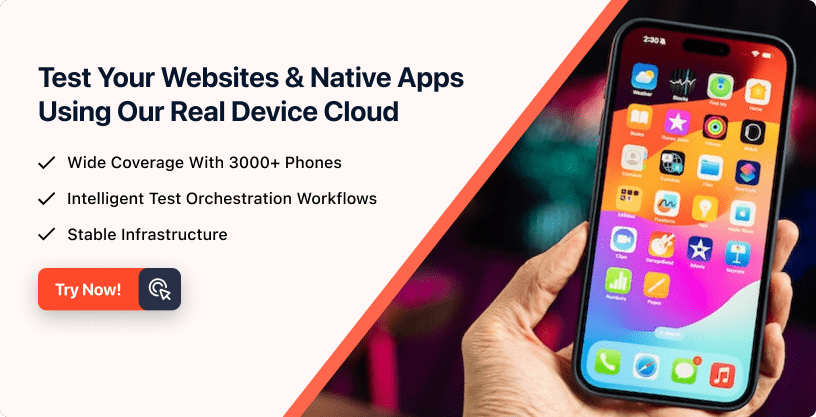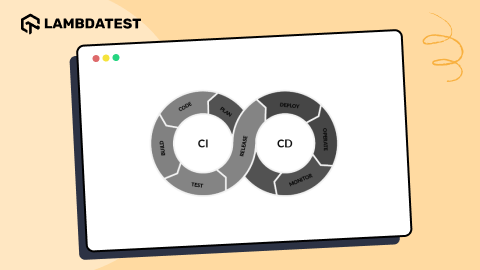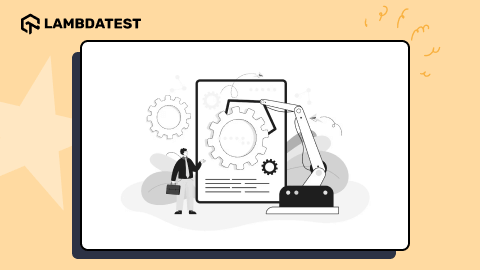23 Software Testing Trends To Look Out For In 2025
Yash Bansal
Posted On: February 3, 2025
![]() 207936 Views
207936 Views
![]() 19 Min Read
19 Min Read
As software continues to play a critical role in businesses and daily life, testing will keep evolving to meet the demands of the modern digital landscape. With that, organizations strive to deliver their software faster and more frequently, and the testing process needs to become more integrated into the development process.
In 2025, we can see various software testing trends emerging, each with the potential to significantly impact how organizations approach testing and ensure software quality.
Software testing will remain an essential aspect of software development, and the demand for skilled software testers will keep increasing daily to ensure that the software performs as intended and meets the end user’s expectations. Hence, software testers must acquire new skills and get insights on the latest trends that can be acquired through software testing YouTube channels.
This article discusses the top 23 software testing trends for 2025 and their impact and scope on organizations. Without ado, let’s dive deep into it.
TABLE OF CONTENTS
- Accelerating Time-to-Market with Shift Left Testing
- Revolutionizing Software Testing with AI and ML
- Empowering Teams to Deliver Secure Software Faster with DevSecOps
- Enabling Faster, Smarter Software Development with Continuous Testing
- Exploring the Possibilities of IoT Testing for Smart Devices and Systems
- Unleashing the Potential of RPA for Faster, Smarter Testing
- Securing Your Digital Footprints with Security Testing
- Impact of Scriptless Automation on the Testing Landscape
- Streamlining Cloud Deployments with Cloud-Native Testing
- Revolutionizing AI Testing with Artificial Neural Network Testing
- Power of Multi-Device Testing for Smarter Test Automation
- Navigating the Cybersecurity Testing Landscape
- The Future of Digital Experience Testing
- Power of User Experience Testing in Driving Business Success
- Blockchain Testing for Enhanced Security and Performance
- Impact of Cloud Performance Engineering on Business Continuity
- Testing of Big Data and Data Analytics
- Unlocking the Potential of Automated Mobile Testing
- Transforming Automation Testing with Chatbots
- Maximizing Efficiency with Real-Device Automation Testing
- Impact of Technology on Virtual and Augmented Reality Testing
- Microservices Testing in the Digital Age
- Making the Most of Image and Video Testing
- Frequently Asked Questions (FAQs)
1. Accelerating Time-to-Market with Shift Left Testing
As software becomes more complex and the need for speed increases, software testing trends like shift left testing, a software testing approach that prioritizes testing earlier in the software development process. Instead of waiting until the end of development to begin testing, shift left testing emphasizes starting testing as soon as the first code is written.
It’s not just about changing the timing of testing activities but also about how testing is done. To accelerate time-to-market, cloud testing platforms like LambdaTest help perform shift left testing that enables developers to test their web applications on a range of real devices and browsers, identify and resolve bugs early in the development cycle, and deliver high-quality software at a faster pace.
If you’re looking to adopt Agile or DevOps practices, our video on shift-left testing is a must-watch. It will help you understand the benefits of shifting testing left and how to do it effectively.

You can also Subscribe to the LambdaTest YouTube Channel and stay updated with the latest tutorials around Selenium testing, Appium, and more.
2. Revolutionizing Software Testing with AI and ML
As testing becomes more automated, software testing trends incorporating AI & ML technologies enhance testing processes, such as utilizing AI algorithms to generate test cases and ML techniques to identify patterns and anomalies in test data.
By leveraging AI and ML algorithms, organizations can significantly increase the speed and accuracy of their testing activities and deliver software with higher quality and reliability. As organizations look to increase the speed, accuracy, and efficiency of their testing activities, the application of AI and ML in automation testing will expand and continue to keep evolving, bringing software testing new and better algorithms.
AI-native test assistants such as KaneAI exemplifies this evolution by integrating intelligent test creation, management, and debugging features.
KaneAI by LambdaTest is a GenAI Native QA Agent-as-a-Service platform that enables teams to create, debug, and refine tests using natural language. Designed specifically for high-speed quality engineering teams, KaneAI enables users to create and evolve complex test cases using natural language, significantly reducing the time and expertise required to get started with test automation.
3. Empowering Teams to Deliver Secure Software Faster with DevSecOps
Software testing trends are shifting towards a more secure approach with DevSecOps, a modern software development methodology that integrates security into the development process, making it a core component of the development lifecycle.
DevSecOps provides a way for organizations to reduce the risk of security vulnerabilities in software by incorporating security into every stage of the development process, from design to deployment. By doing so, organizations can detect and address security issues earlier in the development process when they are less expensive and time-consuming. The scope of DevSecOps will continue to grow as organizations seek to increase the safety of their software and meet the evolving threat landscape.
4. Enabling Faster, Smarter Software Development with Continuous Testing
With the rise of Agile development, faster and more reliable continuous testing has become an essential aspect of this new paradigm as it involves testing the entire development process, from development to deployment. The main objective is to provide early feedback and meet quality expectations before releasing software to end users. As organizations seek to increase speed and quality in their software delivery processes, the scope of continuous testing will continue to grow.
5. Exploring the Possibilities of IoT Testing for Smart Devices and Systems
With the rise of the Internet of Things, software testing trends are shifting towards IoT testing. The Internet of Things (IoT) is a network of interconnected physical objects like cars, appliances, and other household items with connectivity, electronics, and software that allow them to collect and exchange data.
To ensure these devices work effectively and efficiently, security and functional testing are becoming increasingly important as the number of IoT devices increases, leading to high growth in IoT testing. It aims to confirm that IoT systems and devices perform as anticipated and adhere to end users’ expectations.
6. Unleashing the Potential of RPA for Faster, Smarter Testing
As the complexity of RPA solutions continues to grow, software testing trends are moving towards Robotic Process Automation (RPA) testing, a technology that automates routine and repetitive tasks, freeing human workers to focus on higher-value tasks. The goal of RPA automated testing is to ensure that RPA systems function as expected and meet the requirements of the end-users. RPA aims to improve efficiency, reduce errors, and lower costs.
More than ever, there is a need for dependable and effective RPA systems, given the growing use of RPA in crucial systems like finance, healthcare, and customer service. As RPA’s usage and system complexity continue to rise, so will the scope of automated testing for RPA applications. Organizations can ensure the excellence and dependability of their RPA systems by automating the testing process.
7. Securing Your Digital Footprints with Security Testing
To protect users’ data from growing digital threats, software testing trends increasingly focus on incorporating security testing into the software testing life cycle. Because cyberattacks are so sophisticated, security lapses can have catastrophic results, resulting in monetary losses, reputational harm, and the loss of sensitive data.
As a result, organizations now place more emphasis on testing the security of their systems, making security testing a crucial component of software development. As the demand for secure software rises and the complexity of software systems rises, the scope of security testing will expand, allowing businesses to guarantee the security of critical systems like finance and healthcare.
8. Impact of Scriptless Automation on the Testing Landscape
Scriptless automation testing is becoming an increasingly popular choice for software testing trends as it eliminates the need for scripting and coding in software testing. It aims to simplify and streamline the testing process, making it easier for organizations to perform automated testing without requiring specialized technical skills.
It is accomplished using tools that allow testers to create test cases and test scenarios using graphical user interfaces instead of writing code, thus, reducing the time to create and maintain test scripts. The use of codeless automation testing will expand as businesses look for ways to restructure, streamline, and open up the testing process to a broader audience of users.
9. Streamlining Cloud Deployments with Cloud-Native Testing
As software testing trends continue to focus on improving the quality of cloud-based applications, cloud-native testing refers to testing cloud-based applications that are designed, developed, and deployed using cloud-native principles and technologies.
Cloud-native testing guarantees the performance, dependability, and security of cloud-based systems and applications and confirms their suitability for use in contemporary, highly scalable, and dynamic environments. The demand for cloud-based systems and applications is increasing; therefore, cloud-native testing will grow as organizations increasingly adopt cloud-based solutions and technologies.
10. Revolutionizing AI Testing with Artificial Neural Network Testing
Software testing trends are changing to incorporate new testing techniques and strategies for testing AI applications as artificial neural network technology progresses. Testing artificial neural networks (ANN) determines how well a neural network model performs on a particular task or issue. The use of ANNs in numerous applications, including image recognition, medical diagnosis, and autonomous driving, has significantly increased in recent years, where the model’s accuracy and dependability are crucial. The scope of ANN testing is anticipated to grow in the future as deep learning and artificial intelligence progress.
11. Power of Multi-Device Testing for Smarter Test Automation
Software testing trends are putting more emphasis on multi-device testing as the number of connected devices keeps increasing to ensure that applications function properly on all connected devices, including smartphones, tablets, laptops, and smart home devices. Regardless of size, shape, or operating system, multi-device testing ensures that all devices, irrespective of shape and size.
As more people use multiple devices, the scope of multi-device testing will continue to grow in the coming years. LambdaTest allows multi-device testing as parallel testing to test multiple devices and browsers simultaneously, reducing the overall time and effort required for testing. Additionally, LambdaTest’s platform integrates with popular testing frameworks like Selenium and Appium, making it easy for teams to integrate their existing testing processes.
Perform live website testing across 3000+ devices and browser versions Try LambdaTest Now!
12. Navigating the Cybersecurity Testing Landscape
As cybersecurity risks continue to increase, software testing trends are shifting toward more frequent and rigorous testing practices. An organization’s overall security posture is evaluated by conducting cybersecurity testing on its computer systems, networks, and applications to spot potential flaws.
Sensitive data and systems are safeguarded from unauthorized access, theft, and damage thanks to cybersecurity testing, which aims to identify and reduce potential security risks. Cybersecurity testing is anticipated to grow in the upcoming years due to the increased use of mobile devices, cloud computing, and the Internet of Things (IoT).
13. The Future of Digital Experience Testing
With the rise and importance of digital transformation, testing trends are shifting towards more comprehensive testing of the entire digital experience. Digital Experience Testing ensures that organizations’ digital products and services are seamless and offer a good user experience.
In digital experience testing, we can test browser compatibility across various platforms and devices in addition to functionality, usability, and performance. Conducting digital experience testing allows businesses to find and fix problems that have a negative impact on the user experience, which ultimately increases client satisfaction, loyalty, and revenue. Additionally, digital experience testing is a great way for businesses to ensure that their digital goods and services meet user expectations and industry standards.
14. Power of User Experience Testing in Driving Business Success
Modern software testing trends recognize that user experience is crucial to create software that not only works well but also delights users. User experience testing is the process of analyzing how end users interact with a given product or service. It aims to recognize and address problems like poor usability, perplexing navigation, or inconsistent design that may have a negative effect on the user experience.
As the value of the customer experience continues to rise, so will the scope of UX testing. In the upcoming years, it is anticipated that mobile devices, e-commerce, and the growing significance of customer satisfaction will all contribute to the growth of UX and UI testing.
15. Blockchain Testing for Enhanced Security and Performance
As blockchain technology continues to gain momentum, blockchain testing has become a crucial testing trend in software development, and more and more companies are adopting it. This is a crucial step in developing blockchain-based applications that enable businesses to ensure their products are safe and dependable.
Blockchain testing aims to locate and address problems, such as security holes or compatibility issues, that could adversely affect how the blockchain functions. As interest in blockchain technology increases in the upcoming years, so will the scope of blockchain testing.
16. Impact of Cloud Performance Engineering on Business Continuity
Examining and improving the performance of cloud-based applications and services is the key objective of cloud performance engineering, a crucial component of cloud computing among various software testing trends. Cloud provides unparalleled scalability, flexibility, and cost savings, but without proper performance engineering, organizations risk experiencing poor application performance, a diminished user experience, and even financial losses.
Businesses that depend on cloud-based services and applications to ensure their clients are happy and loyal must invest in cloud performance engineering. The demand for cloud performance engineering will only increase due to the ever-increasing complexity and need for cloud-based services. As part of their overall cloud strategy, businesses must therefore give cloud performance engineering priority.
17. Testing of Big Data and Data Analytics
Software testing trends in Big Data and Data Analytics is moving towards automation and using specialized tools to handle the complexity and variety of data. This refers to verifying and validating data pipelines and processing applications that deal with large volumes of data in different formats. The scope of testing is vast and includes verifying data ingestion, storage, processing, analysis, visualization, and modeling.
Testing also ensures data quality, accuracy, and consistency while validating real-time data processing. The scope of testing is expanded due to the complexity of big data systems and requires specialized knowledge and tools to validate the correctness of the processed data.
18. Unlocking the Potential of Automated Mobile Testing
The mobile testing landscape is constantly evolving, with new devices, operating systems, and testing methodologies emerging as software testing trends evolve. Mobile testing is the practice of using automated testing tools to evaluate the performance and functionality of mobile applications. It aids in finding any problems and flaws in the application before it is made available to the general public, guaranteeing that it is of high quality and offers a seamless user experience.
Mobile applications are now crucial for modern businesses to make sure their applications function correctly and perform at their best due to the growing use of mobile devices. Given the continued growth in mobile usage, the scope of automated mobile testing is expanding significantly due to the rising demand for high-quality mobile applications.
LambdaTest offers an AI-powered test orchestration and execution platform to perform mobile app testing for Android and iOS devices without worrying about the device or location. It supports a wide range of best test automation frameworks to test on more than 3000+ browsers, OS, and device combinations.
19. Transforming Automation Testing with Chatbots
In recent software testing trends; chatbots have developed into sophisticated tools that can interact with customers, handle requests, and provide information thanks to artificial intelligence and natural language processing developments. In the context of automation, chatbots have been used in the testing sector to improve and streamline the testing process.
As chatbots provide several advantages to businesses, their use in automation is anticipated to expand significantly in the coming years. Chatbots can speed up the testing process by automating routine tasks so testers can concentrate on more difficult ones. They can also give immediate feedback on test results and automate repetitive tasks.
20. Maximizing Efficiency with Real-Device Automation Testing
Automation on real devices refers to automating tests on real devices, such as smartphones, tablets, and laptops. It accurately represents an application’s performance on real devices, considering device performance, network conditions, and hardware constraints. As the use of mobile devices continues to rise, it is anticipated that the scope of automation on real devices will expand significantly in the coming years of software testing trends.
It enables finding and fixing any problems or flaws in the application before release, lowering the possibility of a poor user experience. Additionally, since manual testing can be time- and resource-intensive, organizations are shifting from manual to automation.
21. Impact of Technology on Virtual and Augmented Reality Testing
In recent times, for software testing trends, Augmented reality (AR) and Virtual reality (VR) technologies have become increasingly popular. Many businesses use these technologies in the entertainment, gaming, educational, and healthcare sectors.
The range of VR and AR testing encompasses confirming the precision and functionality of user interactions, performance, and compatibility testing across various hardware and software configurations, 3D modeling and rendering, audio and visual regression testing, and environmental testing to make sure the virtual or augmented environment is in line with the real world.
22. Microservices Testing in the Digital Age
To keep up with the software testing trends, organizations must shift from traditional monolithic application testing approaches to a more modular and flexible testing strategy, called microservices testing. Microservices is an approach to software development that breaks applications into small, loosely coupled services. The microservice architecture style offers many benefits, including improved scalability, faster development and deployment, and reduced risk of system downtime.
However, it also brings new challenges related to microservice architecture in testing. Despite these challenges, organizations are expected to increase their investment in microservices testing as they adopt this architecture style. However, DevOps can help organizations continuously test and deploy microservices reducing the time to market for new features and improvements.
23. Making the Most of Image and Video Testing
As per recent software testing trends, users now demand high-quality visual experiences from their applications, thanks to the popularity of mobile devices and fast internet access. As a result, businesses are stressing the importance of testing images and videos in their applications.
As visual content becomes more complex, the scope of image testing will keep growing. To meet this demand, organizations use automated testing methods like compression testing to ensure that images are high-performing and of high quality. When manual testing is labor-intensive and prone to mistakes, automated testing also aids organizations in lowering the risk of human error.
Wrapping Up!
The software testing industry is constantly evolving, and 2025 is bringing new software testing trends and technologies to help businesses stay ahead of the competition. Organizations that embrace these trends and invest in robust testing strategies will be well-positioned to deliver high-quality software and meet changing customer needs.
Frequently Asked Questions (FAQs)
1. What is Shift Left Testing?
Shift Left Testing is an approach to software testing in which testing activities are moved leftward in the software development life cycle to occur earlier. This means testing is integrated earlier, starting from the requirements gathering and design phase, and is conducted continuously throughout development. The goal is to catch defects and issues early in the cycle, reducing the cost and time required to fix them later in development.
2. How does DevSecOps impact testing?
DevSecOps impacts testing by promoting early security integration into the software development process, incorporating security testing activities, shifting testing leftward, and emphasizing continuous testing and feedback. This approach ensures that security vulnerabilities are identified and resolved early and that the software is more secure and of higher quality.
3. How does continuous testing differ from traditional testing?
Continuous testing differs from traditional testing by emphasizing conducting tests continuously throughout the software development lifecycle and relying on automated testing tools, scripts, and frameworks to enable rapid and efficient testing. Besides, traditional testing is often conducted only at specific phases of development and may rely more on manual testing methods.
4. Why is security testing becoming increasingly important?
As cyber-attacks, data breaches, and other security threats continue to rise, organizations are becoming increasingly aware of the need to perform security testing. Software is relied upon more than ever before for storing and processing sensitive data; therefore, it is vital that this software is secure. Security testing helps identify vulnerabilities and weaknesses in software before they can be exploited by attackers. As a result, security testing is now an essential part of the software development lifecycle.
Got Questions? Drop them on LambdaTest Community. Visit now
















